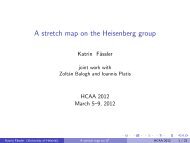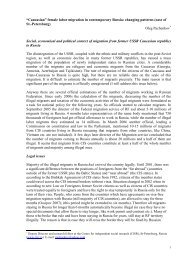THORIUM AS AN ENERGY SOURCE - Opportunities for Norway ...
THORIUM AS AN ENERGY SOURCE - Opportunities for Norway ...
THORIUM AS AN ENERGY SOURCE - Opportunities for Norway ...
You also want an ePaper? Increase the reach of your titles
YUMPU automatically turns print PDFs into web optimized ePapers that Google loves.
Thorium as an Energy Source - <strong>Opportunities</strong> <strong>for</strong> <strong>Norway</strong><br />
5.4.4.1 History<br />
ADS was first proposed by Nobel Prize laureate E.O. Lawrence in the 1950s, mainly as a method<br />
to produce fissile materials by neutron transmutation. Later, the concept was extended to “burn”<br />
nuclear waste. The idea behind “burning” of waste is to use the spallation neutrons to trans<strong>for</strong>m<br />
the waste into other isotopes with a much shorter half life, or, in the case of transuranics to cause<br />
fission. For example, the long-lived fission product technetium-99 (Tc-99) (half life = 211 000<br />
years) changes to Tc-100 (half life = 16 seconds) when a neutron is absorbed in the nucleus. Thus,<br />
after only a few minutes the radioactive Tc-99 is trans<strong>for</strong>med into the stable isotope ruthenium-<br />
100 (Ru-100). A full scale waste transmutation facility was never built, mainly due to the<br />
limitations in the accelerator technology.<br />
By 1990, the accelerator technology had advanced significantly from the 1950s, and significant<br />
ef<strong>for</strong>ts leading to a subcritical molten salt system driven by a linear accelerator were extended in<br />
Los Alamos [84]. In 1993, another Nobel Prize laureate, Carlo Rubbia, revived the idea by<br />
proposing an ADS that could produce energy at the same time as it destroys both its own waste<br />
and waste from other reactors [85], [86], [87], [88], [89], [90], [91] (see Figure 5.8). Rubbia's<br />
concept was called the Energy Amplifier (EA). Several small experimental pilot studies have been<br />
done, but a full scale prototype of the Energy Amplifier has so far not been realized [92], [93],<br />
[94], [95] and [96]. The most active work on ADS in Europe is the MYRRHA project at Mol in<br />
Belgium, which started in 1997 and is planned to be in operation around year 2016 [97], [98],<br />
[99], [100], [101], [102] ,[103], [104] and [105]. MYRRHA is planned to have a subcritical core (keff<br />
≈ 0.95) 7 with MOX fuel (35 wt% plutonium) and will be cooled by lead-bismuth eutectic. The<br />
accelerator will be a 1.5 MW LINAC that delivers protons with an energy of 600 MeV. The<br />
thermal power of the reactor is estimated at 60 MW.<br />
5.4.4.2 Description of the ADS<br />
The ADS consists of two main components:<br />
Figure 5.8: Scheme of an Accelerator Driven System (ADS).<br />
1. The reactor core, whose fuel consists mainly of thorium. At the start-up of the ADS there will<br />
also be some U-235 or Pu or even transuranic waste in the fuel to increase the fission rate. The<br />
core is located close to the bottom of a double walled tank that is 25 meters tall and has a<br />
diameter of 6 meters (see Figure 5.9). The inner tank is filled with molten lead with a<br />
7 The effective neutron multiplication factor (keff).<br />
56

















